July 2012
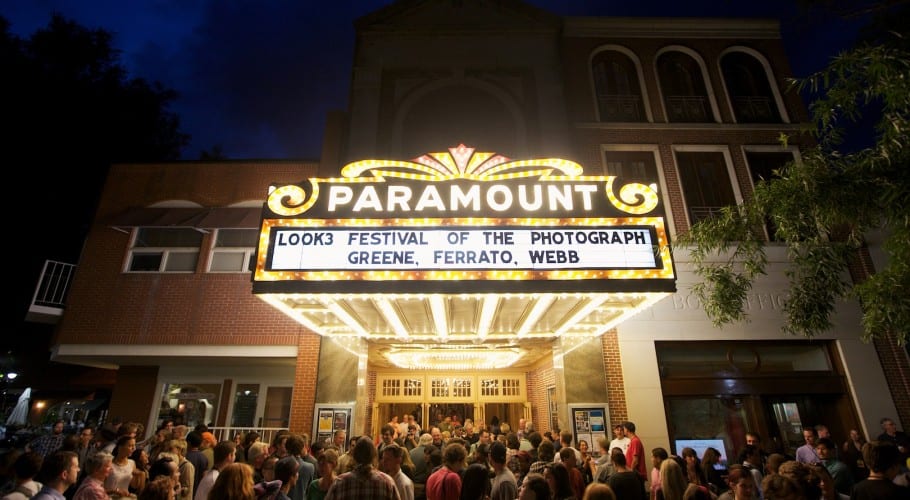
Paramount Theatre Marquee by Tom Daly
Written by Katie O’Grady
A ten-hour drive in the daytime from Georgia to Virginia beats a 12-hour overnight train trip, hands down.
It’s the difference between traveling in a car with two friends versus overnight on a train in seats that “recline,” oh, about four inches, with hundreds of strangers, at least one of whom is unhinged.
It’s the difference between making an unscheduled stop to eat a picnic lunch on church steps in Fancy Gap and watch a small herd of cows cavort across the street, versus making an unscheduled stop in the middle of nowhere in the early morning hours to offload the aforementioned crazy man into the arms of the law whose embrace he shunned vehemently.
It’s the difference between seeing the landscape change from coastal flatlands to verdant mountains, versus a glimpse of ghostly train platforms in the dark.
Charlottesville is a lovely town in its own right, but approaching it through the vineyards and pastures of western North Carolina and Virginia was a visual feast.
Plus, we packed way better food than Amtrak.
As Monty Python was wont to say, “And now for something completely different.” This year’s LOOK3 was certainly not a rerun of the 2011 festival, due in large part to the curators responsible for selecting the photographers and presenters.
Vince Musi, photographer and perennial master of ceremonies for LOOK3, and David Griffin, Visuals Editor of the Washington Post, put together the three-day event, with a heavy emphasis on conflict photography. Understandable; you couldn’t turn around last year without another area or region erupting into conflict. The images and conversations were sobering and dark.
1. The Masters Talks/Insight Conversations
Last year’s riveting and sorrowful presentation by Ashley Gilbertson was leavened nicely with a follow-up presentation by Mary Ellen Mark on her project, Prom, and the conversation between Sally Mann and Nan Goldin was an unexpectedly personal, delightful, and lively event that people were still talking about a year later.
Not so much levity this year. Stanley Greene started out as a fashion photographer, turned to photojournalism in 1989, and has borne witness since then to the atrocities of strife and conflict around the globe. He is currently working on documenting the perils of e-waste in countries paid to take mountains of toxic electronic waste. Stanley was interviewed by Jean François Leroy, director of Visa pour L’Image, a photo festival in Perpignan, France, since 1989.
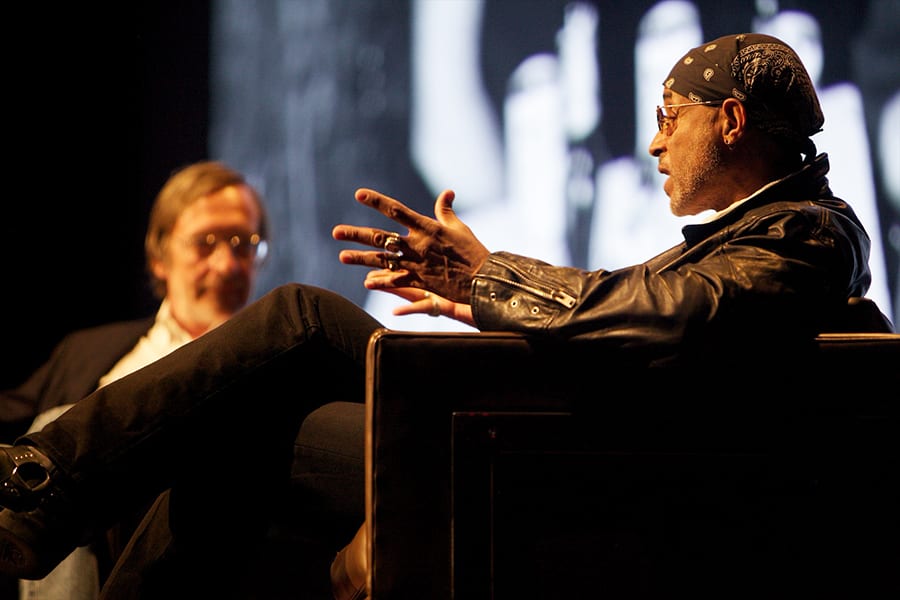
Stanley Green by Tom Daly
Greene is as eloquent with words as he is with images, and his despair was palpable. The heady days of working for a news organization, of having one’s film supplied, of having a support team, are gone. Today’s photojournalists are independents, without an assignment from a sponsor. They must pay their own freight, make their own connections, be responsible for their own security, and then shop their images to the highest bidder.
As a result, photographers strive to produce what the media wants — and if the image captured is not “true” enough, it will be manipulated until it meets expectations. Stanley further asserts that news organizations are enamored of video, and will forsake the riveting still photo for one minute of “you are there” footage. It was never an easy way to make a living; it is now damn near impossible.
So everyone’s doing books. Ernesto Bazan, a noted street photographer who has chronicled life in Cuba in stunning color and black-and-white, has produced several books about his time there, is a publisher himself, and now conducts workshops on how to get one’s work in print.
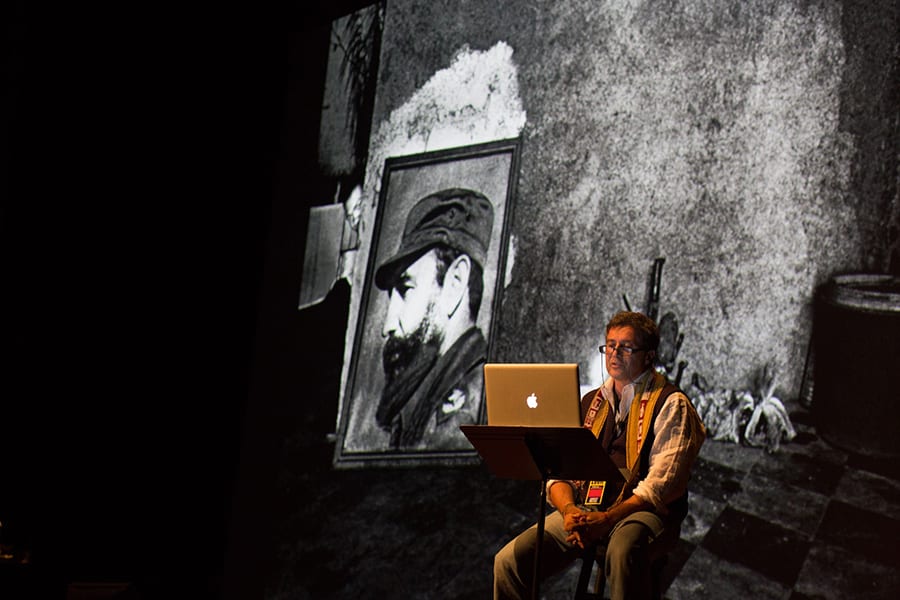
Ernesto Bazan by Brendan Hoffman/Prime
Donna Ferrato produces annual, very limited edition books and is working through Kickstarter to crowd-fund her latest project, Unbeatable. Alex Webb, perhaps the preeminent street photographer, works with his wife, Rebecca Webb, on book projects. David Alan Harvey conducted a master class at LOOK3 on how to publish.
Chris Boot, director of the Aperture Foundation, and a publisher of photography books, gave a delightful presentation. He draws inspiration for the format of his publications from the Ladybird Book series, beloved children’s books in the UK, and then displayed images (and his droll sense of humor) from Welcome to Pyongyang by Charlie Crane, and Meetings, by Paul Shambroom. Where Children Sleep, by James Mollison, presents at once charming-yet-unsettling images of the sleeping spaces juxtaposed by portraits of the children themselves.
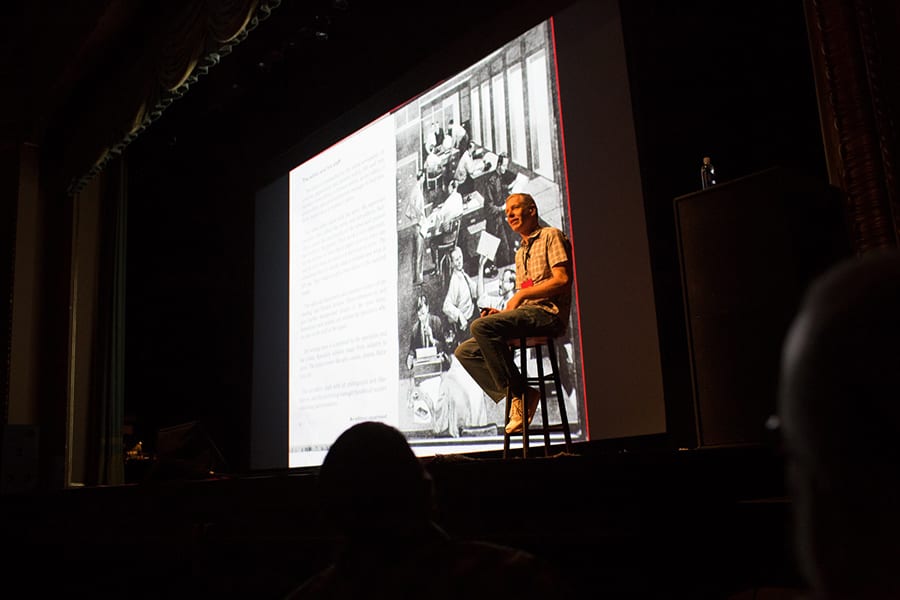
Chris Boot by Brendan Hoffman/Prime
Hank Willis Thomas disarmed us by announcing his nervousness about his fiancée’s parents in attendance, and then proceeded to knock us out with his assertion that “photography is a medium of continuous manipulation, particularly in the advertising industry,” and he takes that manipulation one step further in his work. In one series, he removes all headlines and text from 1960s magazine ads that feature African-Americans. By stripping away the words, he reveals images that are both humorous and horrifying; images that at a core level, he says, “are a reflection of the way culture views itself or its aspirations.”
2. The Exhibits
For sheer majesty, Camille Seaman’s gallery exhibit, The Last Iceberg, had no rival. The subjects and the image sizes themselves were monumental, and provided undeniable, alarming proof of global warming, and the terrible consequences of refusing to acknowledge what we are doing to our planet.
The images in Stanley Greene’s exhibit were so raw and hard to look at that I felt compelled to look — hard — and remember. His straight-on photo of a small Chechen boy sitting on a bed with his two amputated leg stumps and an expression that conveyed, “This is my reality, this is all I’ve ever known … but why?” will remain with me forever.
The McGuffey Art Center hosted Donna Ferrato’s explicit photographs from the 1980s sex-and-drugs scene; and Lynsey Addario’s Veiled Rebellion, images of Afghani women that exposed the horrifically constrained lives they lead; and the POYi (Pictures of the Year International) exhibition. To walk along that long gallery space, taking in photographs of violence, strife, suffering, and perseverance, was to see the terrible things that we have done to one another in one short year.
It was noted in that same 12-month span, that we lost 85 journalists and photojournalists. Their cone of safety, the unwritten rule that they were all afforded neutral status, like the Red Cross/Red Crescent, is no more. Our witnesses to horror, our chroniclers of the unspeakable, are just so much collateral damage themselves now.
3. The Camaraderie
“Same as it ever was.” While the photographs, the conversations, and the talks were decidedly different from last year’s, what remained intact was the utterly un-stratified atmosphere. The pedestrian mall of Charlottesville bustled with throngs of lanyard-festooned participants; and it was entirely possible to find oneself chatting up a world-renowned professional as easily as a freshly-minted Fine Arts graduate.
No one stands on his/her resume at LOOK3. There are stars, per se, but they’re as apt to be in the balcony of the Paramount Theatre with the rest of us listening to their peers as up front in the Big Love seats, or sitting in the grass at the back of the outdoor amphitheater, taking in Shots or Works.
The Truth Booth, sponsored by The Cause Collective, was set up on the lawn of the McGuffey Art Center and was available to anyone who wanted to go on record with their own truth. The resultant clips (displayed on the Paramount Theatre screen on Saturday) were funny, frank, poetic, off the cuff, and heartfelt. A lovely whimsical touch.
This egalitarianism was manifested in a new feature this year: National Geographic Magazine editors offered free 15-minute portfolio reviews on a first-come, first-served basis. Is it the setting — a lovely, old academic town — or the comfort of being among so many like-minded people, that produces such a relaxed, convivial air? Vince Musi sets the “We don’t take ourselves too seriously” tone with his bantering, light-hearted emcee repartee, and the LOOK3 “Peace, Love, and Photography” festival retains much of the backyard-among-friends aura of its origins. It’s just a lot bigger backyard now.
4. The Volunteers
They are large in number, wide-ranging in age, hugely helpful, unceasingly cheerful, and omnipresent from one end of the Mall to the other. They man the registration center, the bookstore, and the exhibitions. They direct, they guide, they usher, and they answer mundane questions over and over and over without the slightest hint of weariness. In fact, to a person, they appeared thrilled at the chance to be a part of LOOK3.
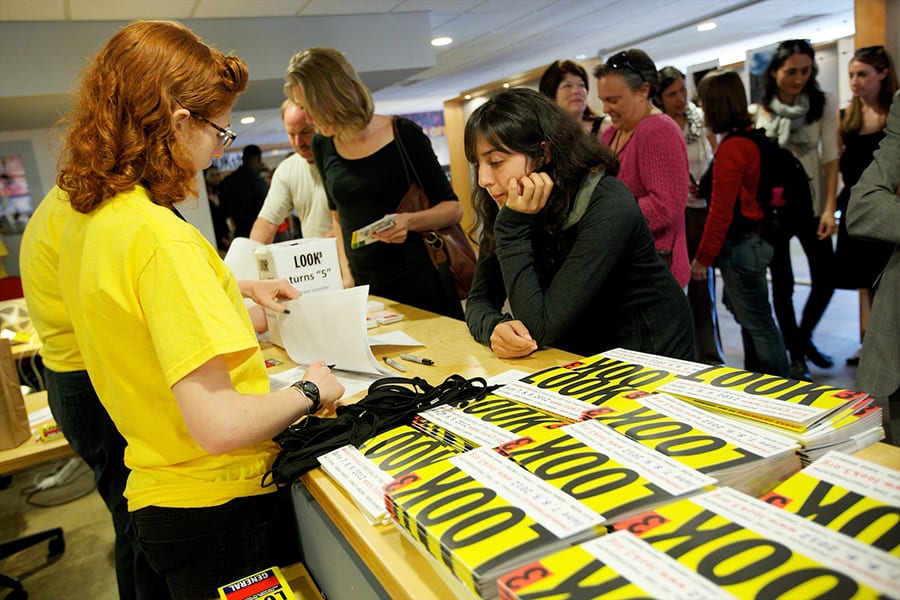
Volunteers by Tom Daly
LOOK3 packs a lot into three days. It is possible to be engaged in some aspect of it from morning through to night. That kind of dense activity demands a highly-evolved sense of organization, and all the volunteer hands on deck one can muster. Hats off to Andrew Owen, managing director, whose sang-froid is amazing, and his happy band of volunteers. They make this festival a can’t-miss. And we won’t.
Next year’s LOOK3 will take place June 13-15, 2013, and the festival curators will be Melissa Harris, editor in chief of Aperture magazine, and Yolanda Cuomo, creative director, Yolanda Cuomo Design and member of the LOOK3 Board of Advisors. And, here we are, back at “And now for something completely different.” Those LOOK3 people know how to mix it up, don’t they?
Oh, yeah, we will so be there. Arriving in a car. In the daylight.
Learn more about the LOOK3 Photography Festival at: http://www.look3.org.
Jerry Atnip
Jerry Atnip has a 38-year career as a commercial and fine art photographer. His images have been published in 40 countries, and since 2003, he’s held over 75 exhibitions and been presented with over 90 awards. He is also a teacher, workshop director, curator, juror, frequent lecturer and serves on the boards of several Arts &
Photography organizations, including Atlanta Celebrates Photography festival and Slow Exposures Photofestival. His work has been collected by museums, corporate and private collectors and he is an Exhibiting Member of The National Arts Club in New York.

